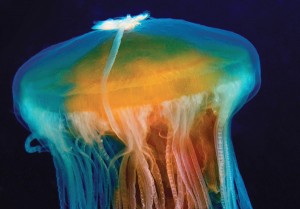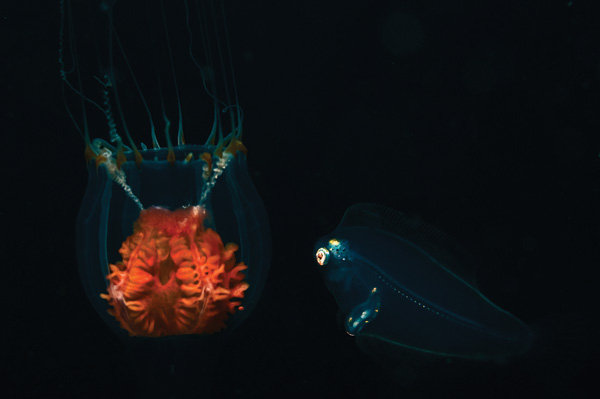From May to July, Southern California’s spring conditions are in full bloom. With the warmer weather and longer hours of sunlight comes California’s famous red tide. Miles offshore, almost as if a line has been drawn, the brown water transforms into a deep pacific blue.
————————————————– 
Words & Photos by Mike Bartick Visit Mike’s website at saltwaterphoto.com
————————————————–
I join a mixed group of photographers and a noted marine biologist for my first California blue water scuba diving experience, 10 miles off the coast of Dana Point. We’ll be hovering below the dive boat, clipped off onto a weighted dropline which is anchored in 2,000 feet of water, making for virtually bottomless diving. It’s here that a variety of small – and not-so-small – sea creatures call home. We’ll be diving from a private vessel, The Sly Fox. Due to a limited demand and the special equipment and techniques necessary for a successful blue water dive, there are few commercial boat operations which offer this type of diving. As the boat idles up to a drifting kelp patty, we investigate to see what it may be hiding. “This is as good a place as any,” says Walter Marti, videographer. “There may be a mola-mola hiding under there.”
Our boat captain, Jim, throws a sea anchor out to slow the drifting boat and we begin to gear up. Both Jim and Walter began their diving careers here with a focus on spearfishing, then somewhere along the line they traded their pole spears for video cameras. Slipping over the edge, I attach my harness line to the dropline hanging below the boat. I exhale and drift into inner space. My mind wanders as I descend, and I realize once again that man knows more about outer space then his own planet. A layer of pelagic invertebrate and gelatinous life coming into view beneath me interrupt my thoughts. I glide through the layer, which resembles an asteroid field, and continue my descent.
The visibility is drastically reduced by the limited sunlight at this depth and the amount of planktonic life in the water. A quick check of my depth gauge reveals that I’m nearing the 80 foot mark, where the water becomes noticeably cooler. I travel further down until finally everything opens up. I level off around the 90 foot mark to get myself oriented. I look up and am awed by the conveyor belt of food swimming above me. I’ve always been amazed at how the largest creatures on earth can be sustained by the smallest. There are several ways to do a blue water dive, but the safest and most practical way is by use of a dropline and harness system. Our dropline is a weighted 110 foot line, and it is secured topside to one of the boat cleats.  Dropping the weighted end over the boat, the weight pulls the line taut. Then we attach another 20 foot line with carabiners on either end, clipping one end to the dropline and the other end to a D-ring on our BCs. Walter likes to use a heavy fishing weight in the middle of the harness line to keep it from continually floating up and creating an entanglement hazard.
Dropping the weighted end over the boat, the weight pulls the line taut. Then we attach another 20 foot line with carabiners on either end, clipping one end to the dropline and the other end to a D-ring on our BCs. Walter likes to use a heavy fishing weight in the middle of the harness line to keep it from continually floating up and creating an entanglement hazard.
Once clipped to the dropline, we can concentrate on shooting photos and not worry about losing the boat. Often times the surface current varies from the currents at different depths. Sometimes a slight breeze will push the boat. Whatever the case may be, making open water ascents without a safety device is never a good idea. Some divers prefer to hang onto the dropline and look into the water column, letting go only when something of interest is in sight. My preference is to swim into the current as far as the dropline will allow. Then, after spotting an animal, I get into position and drift along until I reach the furthest point and pull on the dropline to get one last shot. As my eyes struggle to focus on the cavalcade of drifters, I find that selecting a subject to photograph isn’t exactly easy.
There are so many fascinating visions in the water around me it is difficult to decide on what to shoot first. At times it feels like trying to photograph a housefly in a snowstorm. As I search for my next subject, I’m amazed by an enclave of incredible shape-shifting creatures before me. These are as close to science fiction fantasy as you can get; some even pulsate light and change colors as they drift through the open ocean. I am quickly reminded that in blue water diving, my diving technique is just as important as my photography skills. Relaxing is almost impossible as the current demand’s constant finning and there is no way to escape its grip. From the corner of my eye I see strobes flashing and bright video lights.
I ask myself, “What are they seeing that I’m not?” Then, as if by magic, beautiful jellyfish shimmer and flow past me. Fried Egg Jellyfish (phacellophora camtschatica) vary in size. Luckily, the ones I see today are small, just perfect for the frame of my 60 mm macro lens. Shooting with a single strobe and using my extra long strobe arms, I’m able to get some very dramatic lighting.  Looking closely at the drifting salps and jellies reveals small animals living both among them and on their skins. Seeking shelter from open water predators, various sea life such as small flatfish, medusae fish, pipefish, and amphipods have been seen riding along in the safety provided by these larger fish. My focus now shifts to discovering and shooting these ride-along critters.
Looking closely at the drifting salps and jellies reveals small animals living both among them and on their skins. Seeking shelter from open water predators, various sea life such as small flatfish, medusae fish, pipefish, and amphipods have been seen riding along in the safety provided by these larger fish. My focus now shifts to discovering and shooting these ride-along critters.
My eyes adjust quickly and once into my second dive I begin formulating my shot. Slowing down to find the right subject works for me – it’s not the quantity of photos but rather the quality I’m after. And having a limited amount of opportunity requires readiness and some forethought. We all break for a nice surface interval to discuss the diving and the variety of sea life we have seen so far. The pelagic gelatinous Zooplankton are made up primarily of scyphomedusa, ctenophore’s, pteropod’s, larvations, transparent flatfish, and occasionally pelagic tunicates and mollusks. I soon realize that having a marine biologist on board is pretty handy. Whatever she can’t figure out we look up in our ID books. Most of these open water drifters are transparent, making it difficult for predatory animals to spot them, and even harder for us to photograph them. On occasion, a stunning black sea nettle or a large purple jelly will pass through. These beauties can become very large and ornate with so many little animals living on or in them that they resemble small eco systems unto themselves.
The exciting thing about open water scuba diving is that you never know what will turn up. Mola-molas, sharks, huge jellies, turtles, and dolphins have all been spotted on blue water dives. And while the siren of the sea calls you to investigate, it is essential to exercise caution. Be sure to discuss safety procedures with your team before diving. Overall, the blue water diving experience and the images it offers are worth a million words. If you have the opportunity to participate in a blue water dive, sign up, grab your camera and get out there! This unique diving experience is as incredible as the animals you are sure to encounter.
————————————————————————————————————–
Words & Photos by Mike Bartick Visit Mike’s website at saltwaterphoto.com
————————————————————————————————————–
